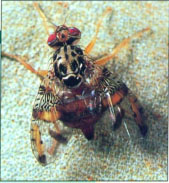All Issues
Introduction: Exotic pests
Publication Information
California Agriculture 52(2):5-5.
Published March 01, 1998
PDF | Citation | Permissions
Full text
California's prominent position on the Pacific Rim, favorable climate, popularity among tourists and abundant agriculture make it particularly vulnerable to exotic pests. A new exotic pest threatens the state's agricultural, natural and urban environments every 60 days.
Agricultural pests, such as the tiny but destructive silverleaf whitefly, are expensive neighbors; the whitefly has cost California agriculture $1 billion since 1991. Urban pests can be equally devastating. Now believed to be established in San Diego County, the Formosan termite could cost 1% of the total value of wooden structures throughout the state.
With its mandate to prevent the entry and establishment of harmful exotic pests, CDFA's monitoring and eradication efforts are also significant. In the past 4 years, for the Mediterranean fruit fly alone, these efforts have cost an estimated $131 million, shared equally by state and federal government.
In the research articles that follow, UC scientists present the current scientific thought on a number of major exotic pests. We begin with three brief news articles, including a look at the UC Center for Exotic Pest Research (CEPR).
By focusing exclusively on exotic pests, the CEPR fills a specialized niche within the university. CEPR is distinct from UC's Center for Pest Management Research and Extension, which serves as a statewide clearinghouse of information and coordinator of research. It is also distinct from the Statewide Integrated Pest Management Project, which develops IPM strategies for established agricultural pests. —Ed.





